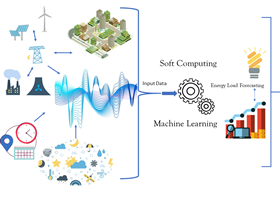Applications of Machine Learning and Soft Computing in Energy Use Forecasting
A special issue of Energies (ISSN 1996-1073). This special issue belongs to the section "F: Electrical Engineering".
Deadline for manuscript submissions: closed (20 April 2023) | Viewed by 18803

Special Issue Editors
Interests: expert systems and knowledge representation; fuzzy cognitive maps, artificial intelligence; modeling and prediction; decision support systems; data mining; machine learning; medical decision making
Special Issues, Collections and Topics in MDPI journals
Interests: fuzzy cognitive maps; artificial neural networks; machine learning; evolutionary algorithms; soft computing; decision support systems; intelligent data analysis
Special Issue Information
Dear Colleagues,
The aim of this Special Issue is to present recent developments in the application of soft computing techniques using novel machine learning algorithms to forecast energy use.
Energy load forecasting has been proven to play a significant role in energy planning and the reduction of consumption. Moreover, the increasing economic and ecological energy costs raise the need to develop new techniques and novel tools which could help in better understanding energy use behavior and finding ways to reduce energy consumption. Nonetheless, there is the need to monitor various variables affecting energy consumption and accurately forecast energy use.
The Special Issue is devoted to original contributions in machine learning algorithms and soft computing techniques applied in energy use forecasting. We invite original papers that showcase innovative models and algorithms, deployed case studies, experimental research, or state-of-the-art reviews on this trajectory. Potential topics include but are not limited to supervised, evolutionary or hybrid learning algorithms, deployment of novel applications on energy use forecasting, explainability models for energy forecasting, comparative analysis of various soft computing, and artificial intelligence models, as well as decision support systems.
Submit your paper and select the Journal “Energies” and the Special Issue “Applications of Machine Learning and Soft Computing in Energy Use Forecasting” via: MDPI submission system. Please contact the special issue editor ([email protected]) for any queries. Our papers will be published on a rolling basis and we will be pleased to receive your submission once you have finished it.
Prof. Dr. Elpiniki I. Papageorgiou
Dr. Katarzyna Poczęta
Guest Editors
Manuscript Submission Information
Manuscripts should be submitted online at www.mdpi.com by registering and logging in to this website. Once you are registered, click here to go to the submission form. Manuscripts can be submitted until the deadline. All submissions that pass pre-check are peer-reviewed. Accepted papers will be published continuously in the journal (as soon as accepted) and will be listed together on the special issue website. Research articles, review articles as well as short communications are invited. For planned papers, a title and short abstract (about 100 words) can be sent to the Editorial Office for announcement on this website.
Submitted manuscripts should not have been published previously, nor be under consideration for publication elsewhere (except conference proceedings papers). All manuscripts are thoroughly refereed through a single-blind peer-review process. A guide for authors and other relevant information for submission of manuscripts is available on the Instructions for Authors page. Energies is an international peer-reviewed open access semimonthly journal published by MDPI.
Please visit the Instructions for Authors page before submitting a manuscript. The Article Processing Charge (APC) for publication in this open access journal is 2600 CHF (Swiss Francs). Submitted papers should be well formatted and use good English. Authors may use MDPI's English editing service prior to publication or during author revisions.
Keywords
- Energy use forecasting
- Time series prediction
- Univariate time series
- Multivariate time series
- Machine learning
- Supervised learning
- Evolutionary optimization
- Hybrid algorithms
- Deep learning
- Fuzzy logic
- Soft computing
- Fuzzy cognitive maps
- Interpretable models
- Artificial neural networks
- Recurrent neural networks
- Expert systems
- Decision support systems
- Energy saving
Benefits of Publishing in a Special Issue
- Ease of navigation: Grouping papers by topic helps scholars navigate broad scope journals more efficiently.
- Greater discoverability: Special Issues support the reach and impact of scientific research. Articles in Special Issues are more discoverable and cited more frequently.
- Expansion of research network: Special Issues facilitate connections among authors, fostering scientific collaborations.
- External promotion: Articles in Special Issues are often promoted through the journal's social media, increasing their visibility.
- e-Book format: Special Issues with more than 10 articles can be published as dedicated e-books, ensuring wide and rapid dissemination.
Further information on MDPI's Special Issue polices can be found here.






